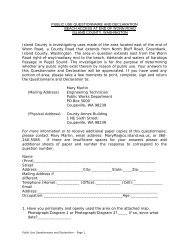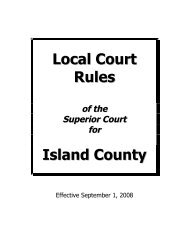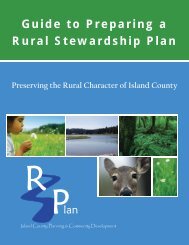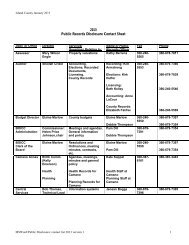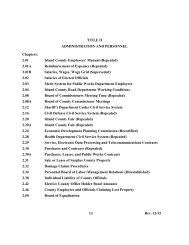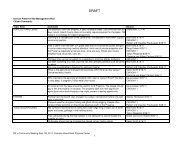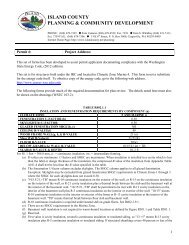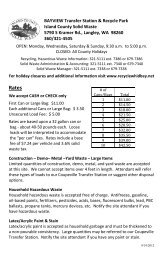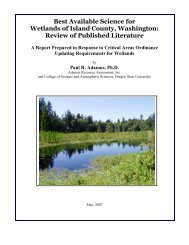Wetland I.D. Guide - Island County Government
Wetland I.D. Guide - Island County Government
Wetland I.D. Guide - Island County Government
Create successful ePaper yourself
Turn your PDF publications into a flip-book with our unique Google optimized e-Paper software.
Field Indicators Worksheet - 3 parts<br />
About the Field Indicators Worksheet<br />
Information provided in the Field Indicators Worksheet helps landowners and applicants identify if their<br />
property contains or is affected by a wetland or wetland buffer. This Worksheet is required to be submitted<br />
with all development proposals. <strong>County</strong> Planners will review the submitted Worksheet and issue a Critical Area<br />
Determination.<br />
As discussed earlier, an area must meet three specific criteria to be considered a wetland: First, a wetland must<br />
have hydrological indicators. Secondly, only specific types of Vegetation can grow in a wetland. Lastly, a<br />
wetland must have specific soil conditions. Most wetlands have all three characteristics.<br />
tools You May need<br />
shoVel<br />
Used to dig hole for hydrology<br />
test and to collect soil sample<br />
MeAsURIng tApe<br />
Used to measure depth of hole<br />
for hydrology test and soil sample<br />
MAchete<br />
May be used to cut small trail<br />
for access to potential wetlands<br />
Section #1 - HYDROLOGY<br />
Hydrology is the movement and distribution of water. Determining hydrology<br />
is important because wetlands need to have water present at some time of<br />
the year for at least 2-3 weeks. The Hydrology Section (Questions 1-6) of<br />
the Field Indicators worksheet guides in the identification of water on or near<br />
your property, how frequently water is present, and how it enters/exits your<br />
property.<br />
Section #2 - VEGETATION<br />
The Vegetation Section (Questions 7-8) of the Field Indicators Worksheet helps<br />
to identify the type of plants you have on your property. Because only certain<br />
types of plants can survive in the oxygen-deprived soils that are characteristic<br />
of wetlands, there are certain indicator plants that can be used to verify the<br />
presence of a wetland. Brief descriptions as well as detailed photographs are<br />
provided in the <strong>Wetland</strong> Vegetation Section of this guide.<br />
Section #3 - SOIL<br />
The Soils Section (Questions 9-11) of the Field Indicators Worksheet will help<br />
you determine if your property has wetland soils. Technically termed “hydric<br />
soils”, these soils serve as an essential indicator for determining the presence of<br />
a wetland. Hydric soils are created in areas where water displaces oxygen that<br />
would otherwise be present.<br />
6<br />
cAMeRA<br />
Pictures provide helpful information<br />
about land characteristics



